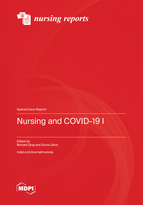Nursing and COVID-19 Ⅰ
A special issue of Nursing Reports (ISSN 2039-4403).
Deadline for manuscript submissions: closed (31 December 2022) | Viewed by 117266
Special Issue Editors
Interests: mental health services; psychosocial interventions; co-morbidity; workforce
Special Issues, Collections and Topics in MDPI journals
Interests: nurse manager development; nurse leader role in transitions of care; nurses' work environments; health care quality; qualitative research approaches; healthcare leadership
Special Issues, Collections and Topics in MDPI journals
Special Issue Information
Dear Colleagues,
Nurses have been a frontline workforce in managing the COVID-19 pandemic, and there are many important reflections and observations that need to be discussed and shared by clinicians and researchers. This Nursing Reports Special Issue on “Nursing and COVID-19” will provide a platform to highlight the issues and challenges faced by nurses practicing in hospital and community settings during the pandemic by bringing together experts to present evidence-based discussions on the impact, experience, and reality of providing evidence-based nursing care during the crisis. We are particularly interested in papers that examine the psychosocial impact of COVID-19 on nurses, showcase novel and innovative ways of delivering patient care (e.g., telehealth), and consider the organizational and management challenges of providing a safe and effective nursing service. This timely dialogue is highly relevant, as the COVID-19 pandemic continues to profoundly impact the way in which we live and work.
You may choose our Joint Special Issue in International Journal of Environmental Research and Public.
Prof. Dr. Richard Gray
Dr. Sonia Udod
Guest Editor
Manuscript Submission Information
Manuscripts should be submitted online at www.mdpi.com by registering and logging in to this website. Once you are registered, click here to go to the submission form. Manuscripts can be submitted until the deadline. All submissions that pass pre-check are peer-reviewed. Accepted papers will be published continuously in the journal (as soon as accepted) and will be listed together on the special issue website. Research articles, review articles as well as short communications are invited. For planned papers, a title and short abstract (about 100 words) can be sent to the Editorial Office for announcement on this website.
Submitted manuscripts should not have been published previously, nor be under consideration for publication elsewhere (except conference proceedings papers). All manuscripts are thoroughly refereed through a single-blind peer-review process. A guide for authors and other relevant information for submission of manuscripts is available on the Instructions for Authors page. Nursing Reports is an international peer-reviewed open access quarterly journal published by MDPI.
Please visit the Instructions for Authors page before submitting a manuscript. The Article Processing Charge (APC) for publication in this open access journal is 1800 CHF (Swiss Francs). Submitted papers should be well formatted and use good English. Authors may use MDPI's English editing service prior to publication or during author revisions.
Keywords
- COVID-19
- nursing
- pandemic
- public health
- workforce








